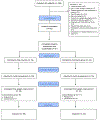Erratum: The Dietary Intervention to Enhance Tracking with Mobile Devices (DIET Mobile) Study: A 6-Month Randomized Weight Loss Trial
- PMID: 29178582
- PMCID: PMC6859842
- DOI: 10.1002/oby.22076
Erratum: The Dietary Intervention to Enhance Tracking with Mobile Devices (DIET Mobile) Study: A 6-Month Randomized Weight Loss Trial
Abstract
Objective:: To examine the use of two different mobile dietary self-monitoring methods for weight loss.
Methods:: Adults with overweight (n = 81; mean BMI 34.7 ± 5.6 kg/m2) were randomized to self-monitor their diet with a mobile app (App, n = 42) or wearable Bite Counter device (Bite, n = 39). Both groups received the same behavioral weight loss information via twice-weekly podcasts. Weight, physical activity (International Physical Activity Questionnaire), and energy intake (two dietary recalls) were assessed at 0, 3, and 6 months.
Results:: At 6 months, 75% of participants completed the trial. The App group lost significantly more weight (−6.8 ± 0.8 kg) than the Bite group (−3.0 ± 0.8 kg; group × time interaction: P < 0.001). Changes in energy intake (kcal/d) (−621 ± 157 App, −456 ± 167 Bite; P = 0.47) or number of days diet was tracked (90.7 ± 9.1 App, 68.4 ± 9.8 Bite; P = 0.09) did not differ between groups, but the Bite group had significant increases in physical activity metabolic equivalents (+2015.4 ± 684.6 min/wk; P = 0.02) compared to little change in the App group (−136.5 ± 630.6; P = 0.02). Total weight loss was significantly correlated with number of podcasts downloaded (r = −0.33, P < 0.01) and number of days diet was tracked (r = −0.33, P < 0.01).
Conclusions:: While frequency of diet tracking was similar between the App and Bite groups, there was greater weight loss observed in the App group.
Conflict of interest statement
Erratum for
-
The Dietary Intervention to Enhance Tracking with Mobile Devices (DIET Mobile) Study: A 6-Month Randomized Weight Loss Trial.Obesity (Silver Spring). 2017 Aug;25(8):1336-1342. doi: 10.1002/oby.21889. Epub 2017 Jun 10. Obesity (Silver Spring). 2017. PMID: 28600833 Free PMC article. Clinical Trial.
References
-
- Turner-McGrievy GM, Beets MW, Moore JB, Kaczynski AT, Barr-Anderson DJ, Tate DF. Comparison of traditional versus mobile app self-monitoring of physical activity and dietary intake among overweight adults participating in an mHealth weight loss program. J Am Med Inform Assoc 2013;20:513–518. - PMC - PubMed
Publication types
Grants and funding
LinkOut - more resources
Full Text Sources
Other Literature Sources


